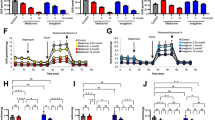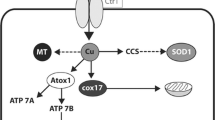Abstract
Copper overload and deficiency are known to cause morphological and functional mitochondrial abnormalities. The reverse transcriptase-polymerase chain reaction (RT-PCR)-based method of differential display of mRNA was used to identify genes with altered expression in cultured human hepatoma cells (Hep G2) exposed to increasing concentrations of copper (0–100 ΜM, 24 h). Copper regulation of a cloned PCR product, identified as the gene for the mitochondrially encoded cytochromeb, was confirmed by Northern analysis andin situ hybridization. Copper toxicity increased cytochromeb mRNA abundance up to 3.6-fold, and copper chelation reduced it by 50%. Hepatic cytochromeb mRNA was also increased in rats fed a high-copper diet. Thapsigargin treatment resulted in a significant increase in cytochromeb mRNA, suggesting that an increase in intracellular calcium may be involved in the mechanism of copper action. Furthermore, although cyclohexamide (CHX) alone did not increase cytochromeb mRNA, the addition of CHX and copper resulted in a sixfold increase. These data suggest a role for cytochromeb in the response to increases or decreases in hepatic copper.
Similar content being viewed by others
References
T. H. Mikhail, W. G. Nicola, K. H. Ibrahim, S. H. Salama, and M. Emam, Abnormal zinc and copper metabolism in hepatic steatosis,Boll. Chim. Farm. 135, 591–597 (1996).
J. Aaseth, Y. Thomassen, E. Aadland, O. Fausa, and E. Schrumpf, Hepatic retention of copper and selenium in primary sclerosing cholangitis,Scand. J. Gastroenerol. 30, 1200–1203 (1995).
I. H. Scheinberg and I. Sternlieb, Wilson disease and idopathic copper toxicosis,Am. J. Clin. Nutr. 63(Suppl.), 842–845S (1996).
S. Toyokuni, S. Okada, S. Hamazaki, M. Fujioka, J. Li, and O. Midorikawa, Cirrhosis of the liver induced by cupric nitrilotriacetate in Wistar rats: an experimental model of copper toxicosis,Am. J. Pathol. 134, 1263–1274 (1989).
M. Sawaki, A. Hattori, N. Tsuzuki, N. Sugawara, K. Enomoto, N. Sawada, et al., Chronic liver injury promotes hepatocarcinogenesis of the LEC rat,Carcinogenesis 19, 331–335 (1998).
M. Harada, S. Sakisaka, M. Yoshitake, S. Shakadoh, K. Gondoh, M. Sata, et al., Tanikawa, Biliary copper excretion in acutely and chronically copper-loaded rats.Hepatology 17, 111–117 (1993).
J. S. Kumaratilake and J. M. Howell, Lysosomes in the pathogenesis of liver injury in chronic copper poisoned sheep: an ultrastructural and morphometric studyJ. Comp. Pathol. 100, 381–390 (1989).
B. M. Myers, F. G. Prendergast, R. Holman, S. Kuntz, and N. F. LaRusso, Alterations in hepatocyte lysosomes in experimental hepatic copper overload in rats,Gastroenterology 105, 1814–1823 (1993).
R. S. Britton, Metal-induced hepatoxicity,Semin. Liver Dis. 16, 3–12 (1996).
I. Sternlieb, N. Quintana, I. Volenberg, and M. L. Schilsky, An array of mitochondrial alterations in the hepatocytes of Long-Evans Cinnamon rats,Hepatology 22, 1782–1787 (1995).
I. Sternlieb, Mitochondrial and fatty changes in hepatocytes of patients with Wilson’s disease,Gastroenterology 55, 354–367 (1968).
H. Seo, B. Xie, S. Wang, H. Yoshikawa, T. Oyamada, and T. Yoshikawa, Ultrastructure of hepatocytes in copper-deficient Sika deer,J. Comp. Pathol. 114, 283–290 (1996).
R. J. Sokol, M. W. Devereaux, K. O’Brien, R. A. Khandwala, and J. P. Loehr, Abnormal hepatic mitochondrial respiration and cytochrome c oxidase activity in rats with long-term copper overload,Gastroenterology 105, 178–187 (1993).
O. Strubelt, J. Kremer, A. Tilse, J. Keogh, R. Pentz, and M. Younes, Comparative studies on the toxicity of mercury, cadmium, and copper toward the isolated perfused rat liver,J. Toxicol. Environ. Health 47, 267–283 (1996).
D. P. Aden, A. Fogel, S. Plotkin, I. Damjanov, and B. B. Knowles, Controlled synthesis of HbsAg in a differentiated human liver carcinoma-derived cell line,Nature 282, 615–616 (1979).
B. B. Knowles, C. C. Howe, and D. P. Aden, Human hepatocellular carcinoma cell lines secrete the major plasma proteins and hepatitis B surface antigen,Science 209, 497–499 (1980).
P. Chomczynski and N. Sacchi, Single-step method of RNA isolation by acid guanidinium thiocyanate-phenol-chloroform extraction,Anal. Biochem. 162, 156–159 (1987).
D. L. Greenman, R. L. Morrissey, E. Blakemore, J. Crowell, P. Siitonen, P. Felton, et al., Subchronic toxicity of triethylenetetramine dihydrochloride in B6C3F1 mice and F344 rats,Fundam. Appl. Toxicol. 29, 185–93 (1996).
A. R. Perry, A. Pagliuca, E. J. Fitzsimons, G. J. Muft, and R. Williams, Acquired sideroblastic anaemia induced by a copper-chelating agent,Int. J. Hematol. 64, 69–72 (1996).
C. W. Levenson and M. Janghorbani, Long-term measurement of organ copper turnover in rats by continuous feeding of a stable isotope,Anal. Biochem. 221, 243–249 (1994).
R. Liang and A. B. Pardee, Differential display of eukaryotic messenger RNA by means of the polymerase chain reaction,Science 257, 967–971 (1992).
R. K. Blanchard and R. J. Cousins, Differential display of intestinal mRNAs regulated by dietary zinc,Proc. Natl. Acad. Sci, USA 93, 6863–6868 (1996).
D. L. Spector, R. D. Goldman, and L. A. Leinwand, In situ hybridization to RNA, inCells: A Laboratory Manual. Cold Spring Harbor Laboratory, Cold Spring Harbor, NY, Vol. 3, pp. 116.1–116.16 (1998).
J. Y. Tso, X. H. Sun, T. H. Kao, K. S. Reece, and R. Wu, Isolation and characterization of rat and human glyceraldehyde-3-phosphate dehydrogenase cDNAs: genomic complexity and molecular evolution of the gene,Nucleic Acids Res. 3, 2485–502 (1985).
D. Tyler,The Mitochondrion in Health and Disease, VCH, New York (1992).
R. J. Sokol, D. Twedt, J. M. McKi, M. W. Devereaux, F. M. Karrer, I. Kam, et al., Oxidant injury to hepatic mitochondria in patients with Wilson’s disease and Bedlington terriers with copper toxicosis,Gastroenterology 107, 1788–1798 (1994).
R. E. C. Wildman, R. Hopkins, M. L. Failla, and D. M. Medeiros, Marginal copperrestricted diets produce altered cardiac ultrastructure in the rat,Proc. Soc. Exp. Biol. Med. 210, 43–49 (1995).
D. M. Medeiros, J. Davidson, and J. E. Jenkins, A unified perspective on copper deficiency and cardiomyopathy,Proc. Soc. Exp. Biol. Med. 203, 262–273 (1993).
M. Guerineau, S. Guerineau, and C. Gosse, Abnormal mitochondria DNA molecules in megamitochondria from cuprizone treated rats,Eur. J. Biochem. 47, 313–319 (1974).
B. Kaminska, L. Kaczmarek, S. Larocque, and A. Chaudhuri, Activity-dependent regulation of cytochrome b gene expression in monkey visual cortex,J. Comp. Neurol. 379, 271–282 (1997).
H. Suzuki, T. Kumagai, A. Goto, and T. Sugiura, Increase in intracellular hydrogen peroxide and upregulation of a nuclear respiratory gene evoked by impairment of mitochondrial electron transfer in human cells,Biochem. Biophys. Res. Commun. 249, 542–545 (1998).
S. Strand, W. J. Hofmann, A. Grambihler, H. Hug, M. Volkman, G. Otto, et al., Hepatic failure and liver cell damage in acute Wilson’s disease involve CD95 (APO-1/Fas) mediated apoptosis,Nat. Med. 4, 588–93 (1998).
H. Hug, S. Strand, A. Grambihler, A. Galle, V. Hack, W. Stremmel, et al., Reactive oxygen intermediates are involved in the induction of CD95 ligand mRNA expression by cytostatic drugs in hepatoma cells.J. Biol. Chem. 272, 28191–28193 (1997).
C. V. Demonacos, N. Karayanni, E. Hatzoglou, C. Tsiriyiotis, D. A. Spandidos, and C. E. Sekeris, Mitochondrial genes as sites of primary action of steroid hormones,Steroids 61, 226–232 (1996).
C. Demonacos, R. Djordjevic-Markovic, N. Tsawdaroglou, and C. E. Sekeris, The mitochondrion as a primary site of action of glucocorticoids: the interaction of the glucocorticoid receptor with mitochondrial DNA sequences showing partial similarity to the nuclear glucocorticoid responsive elements,J. Steroid Biochem. Mol. Biol. 55, 43–55 (1995).
K. Umesono and R. M. Evans, Determinants of target gene specificity for steroid/thyroid hormone receptors,Cell 57, 1139–1146 (1989).
P. F. Predki and B. Sarkar, Metal replacement in “zinc finger” and its effect on DNA binding,Environ. Health Perspect. 102(Suppl. 3), 195–198 (1994).
W. Chen and C. L. Dieckmann, Genetic evidence for interactio between Cbp 1 and specific nucleotides in the 5′ untranslated region of mitochondrial cytochrome b mRNA in Saccharomyces cerevisiae,Mol. Cell Biol. 17, 6203–6211 (1997).
W. E. N. D. Evering, S. Haywood, I. Bremner, and J. Trafford, The protective role of metallothionein in copper overload: I. Differential distribution of immunoreactive metallothionein in copper-loaded rat liver and kidney,Chem.-Biol. Interact. 78, 283–295, 1991.
O. M. Steinebach, and H. T. Wolterbeek, Effects of copper on rat hepatoma HTC cells and primary cultured rat hepatocytes,J. Inorg. Biochem. 53, 27–48 (1994).
Author information
Authors and Affiliations
Rights and permissions
About this article
Cite this article
Levenson, C.W., Song, Y., Narayanan, V.S. et al. Regulation of mitochondrial cytochromeb mRNA by copper in cultured human hepatoma cells and rat liver. Biol Trace Elem Res 70, 149–164 (1999). https://doi.org/10.1007/BF02783856
Received:
Revised:
Accepted:
Issue Date:
DOI: https://doi.org/10.1007/BF02783856




